Big-name coaches on the move. Ballooning contracts. Finger-pointing all around. What does it mean for college sports? SI asked those in the know.
LSU athletic director Scott Woodward stood in a room under Tiger Stadium’s north end zone, watching Oklahoma State mount a second-half comeback against rival Oklahoma just minutes after his own Tigers upset Texas A&M in their regular-season finale.
He wasn’t alone. Football staff members filtered in and out of the room, everyone glued to the television for very different reasons. Most of them had a vested interest in the game’s outcome. If the Cowboys beat the Sooners, they thought, it might open the door for Oklahoma coach Lincoln Riley to replace Ed Orgeron at the helm.
Woodward didn’t hold such a view. Unbeknownst to many in Baton Rouge, he had already targeted his finalist for the job days earlier. While the city and LSU community buzzed about Riley, a small group of people knew the truth. If there were ever any discussions with Riley, they had ended. Riley was not interested in the job and had conveyed such to Oklahoma administrators, industry sources say.
Days before last weekend’s regular-season finale of games, Woodward headed into the final stretch of his six-week search, juggling communication between what appeared to be his final two candidates. He made one last call to close friend and A&M coach Jimbo Fisher to gauge his interest before entering more serious discussions with Trace Armstrong, the agent for Notre Dame coach Brian Kelly.
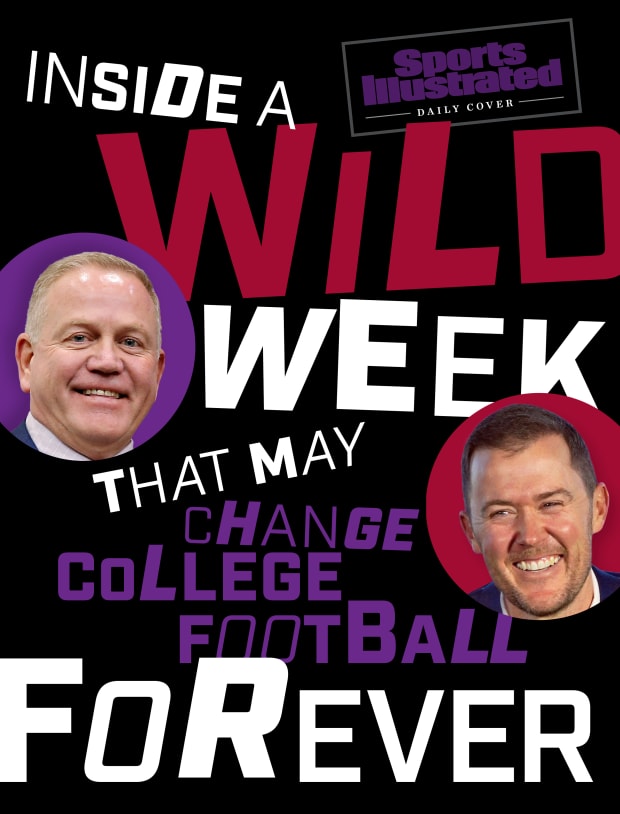
Jonathan Bachman/Getty Images (Kelly); Kirby Lee/USA TODAY Sports (Riley)
“We had already basically made the deal in terms of … [Kelly] was going to come here,” says one prominent LSU official with knowledge of the final days of the search. “It was jaw-dropping to me to see the things [that were] written. It was completely wrong.”
Because of that false hope, many LSU fans were shocked and dismayed when Riley denied interest. “I’m not going to be the next head coach at LSU,” he told reporters after the Bedlam loss. “Next question.”
Meanwhile, Woodward quietly walked out of Tiger Stadium after watching Oklahoma State’s game-winning defensive stand, saying little to anyone that night, aside from a line he repeated to dozens of people over the final week of his coaching search. “We’ve got someone,” sources recall him saying, “and you’re going to be happy about it.”
It just wasn’t who LSU fans had initially believed would be coming to Baton Rouge. Less than 24 hours after denying the Tigers rumors, Riley announced he was headed west to USC. And within a day after that, Woodward’s hire was made known: He lured Kelly from Notre Dame. The two moves shook college football in an unprecedented 36 hours.
Not one but two of the country’s winningest coaches in recent memory abandoned their programs to take over fellow powerhouse schools, signing contracts that are each expected to eclipse $100 million and stretch a decade in term. What’s more, one of those coaches, Kelly, left a team that has a chance to advance to the College Football Playoff. Both coaches made misdirection plays on their way out the door—Riley telling only half of the truth about where he would or would not be coaching, and Kelly finalizing the deal with LSU while on the road recruiting for Notre Dame.
The extraordinary moves have thrown a sport already heavily criticized for its lavish spending into a deeper divide.
Sports Illustrated talked to more than a dozen people within college athletics in various capacities about what the coaches’ moves say about the broader context of college sports.
Stakeholders fear the big-money contracts will start a ripple effect that will further widen the gap between college football’s haves and have-nots. One U.S. senator told SI the decisions will spark more congressional interference in the college world, while administrators say they are concerned about further impacts on Olympic sports, which have routinely borne the brunt of the spare-no-expense spending on football.
While the U.S. economy struggles to rebound financially in a post-COVID-19 world, college football coaching salaries are spiking to exorbitant levels, contracts are extending to record lengths and buyouts are at a historic high. No year has included so many early-season firings, as schools have spent more than a combined $90 million to show coaches the door in this season alone.
Some of the sources who spoke to SI believe social media has directly impacted decisions. Fans and boosters, searching for the new Nick Saban, have empowered themselves, while athletic administrators are losing contract battles with the game’s real movers and shakers: agents.
“It’s bats--- crazy,” says one conference commissioner who asked for anonymity. “The schools clearly aren’t in control.”
In 1999, LSU hired a man named Nick Saban, paying him an annual salary of $1.2 million, believed to be the most by a school to its new coach. In 2004, the school made Saban the first college coach to make at least $2 million. The chancellor who approved those contracts: Mark Emmert, who is now the president of the NCAA.
Woodward, then a lieutenant beneath Emmert, and SEC powerhouse LSU have now reset the coaching market again. LSU’s contract with Kelly makes him, for now, the highest-paid public-school coach in the country. His deal averages between $10 million to $10.5 million a year (on par with many NFL coaches) and includes $1 million in built-in supplementation, a way for a program to avoid a large salary figure. He receives $500,000 in an annual “longevity bonus” and another $500,000 for making a bowl game. LSU had made 20 straight bowl appearances before last season and won three national championships over that span.
As AD at Texas A&M, Woodward had previously signed Jimbo Fisher to what was then the most exorbitant contract in college football history—a guaranteed, 10-year, $75 million deal. (In preparation for this year’s wild coaching carousel, current A&M AD Ross Bjork extended Fisher’s contract for 10 more years in a deal now worth $95 million.)
“We are on an unsustainable path,” says one former LSU Board of Supervisors member. “I know it’s private money, but this is still money donors could give to the engineering department or the academic side. We have to lobby harder for salary caps. It’s out of whack.”
That said, the hire pumped excitement back into the bayou.
Just two years removed from their last title in 2019, the Tigers are 11–11 over the past two seasons. Woodward’s goal at the start of the search was to get a “big, proven fish,” says one person close to the AD. Early in the search process, he and a small committee of administrators identified six or so candidates, a who’s who in the sport: Fisher, Franklin, Kelly, Tucker, Riley and NFL coach Matt Rhule. Woodward reduced the list to two or three finalists who were seriously interested in coming to Baton Rouge.
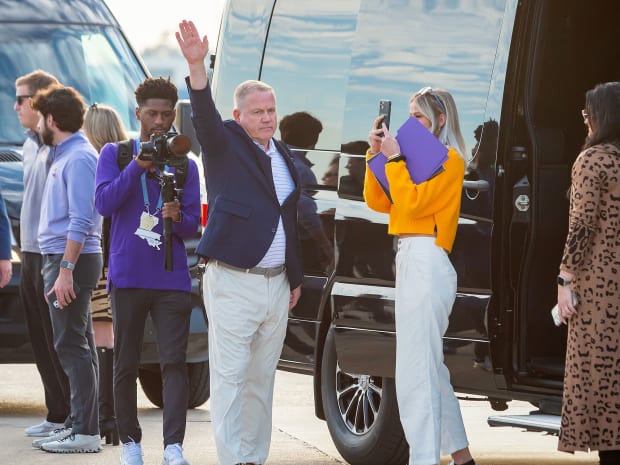
Scott Clause/USA TODAY Network
“[Kelly] was willing to dance,” says one LSU source, “so we kept working it.”
Kelly was actually open to dancing with several programs. When Florida’s job opened, its officials were alerted that Riley and Kelly were willing to move, sources tell SI. The Gators were already set on their No. 1 target and the coach they eventually hired, Napier. During the final week of the regular season as Oklahoma State was preparing to play Bedlam, at least one AD received an email from a marketing agent representing Mike Gundy, saying he was interested in the job.
Kelly’s dance with LSU wasn’t short. Administrators at Notre Dame knew of Kelly’s interest to leave well before last week, and there were signs over the final month of the regular season the coach was bound to exit.
“There is a sense you get when you work with somebody for 12 years that there is a restlessness,” Notre Dame AD Jack Swarbrick told reporters during a news conference Tuesday. “There were Freudian slips along the way that grabbed my attention. It felt like someone open to a new opportunity."
After Notre Dame’s home finale, against Georgia Tech, Kelly addressed his seniors by saying, “For some of us this is our last game here”—a comment that one source says caught the attention of several people in the room. Some of us?
Kelly’s agent, Armstrong, contacted the Notre Dame administration about contract enhancements multiple times over the final weeks of the season, but no final offer was brought to the Irish to match. Kelly notified Notre Dame officials of his departure about 30 minutes after initial reports surfaced online, and the coach was recruiting a prospect in California when the news trickled out.
In Baton Rouge, LSU administrators hurriedly scheduled an emergency meeting of the Board of Supervisors to announce the decision. Woodward delivered on his promise to land a big fish, even if it’s not the one Baton Rouge had buzzed about hours earlier.
“A lot of people are disappointed we didn’t get Lincoln Riley,” says one prominent booster at the school. “Scott went after his man. He was focused on him. He went out and got the best. That’s why LSU hired Scott.”
Meanwhile, those within the industry who spoke to SI praised USC for its ability to keep its negotiations with Riley under the radar given the size of the program and its media market.
Said one Power 5 AD of USC AD Mike Bohn: "He was a magician."
Two blueblood coaching jobs opening up in such a short period of time has become the new normal, stakeholders in the sport believe. But what Riley and Kelly did is simply without modern precedent. No sitting Notre Dame coach has left for a different job on his own volition since 1907, and the last time an Oklahoma coach left for another position was ’47. Notre Dame is also within range of a College Football Playoff berth. (Although the Fighting Irish need help to make the four-team field with their current No. 6 ranking, it would not take much for them to earn it.)
“It’s a roller-coaster ride right now, trying to anticipate,” says Drew Turner, vice president of Collegiate Sports Associates, a search firm. “By the time the news breaks of something opening, they’re either probably already working with a firm or you’re probably too late because it’s such a crazy movement, so you’re trying to anticipate what could open next on this carousel ride.”
Most people whom SI spoke with blame the expedited coaching carousel on the additional early signing period. For decades, there was only one signing day in football, in early February. Starting in 2017, a mid-December date was instituted to aid prospects who had made decisions and coaches who wanted their classes secured before the last recruiting push in January.
The early date has sped up the carousel spin, but it’s only part of the equation, says Daniel Parker, who leads Parker Executive Search’s sports division. The movement among players is at an all-time high. The transfer portal and the one-time transfer exception—allowing players to transfer once and play immediately—makes it more difficult to drag searches deep into December. The new coach needs to be hired quickly to begin recruiting players on their own team as much as those on future teams.
“I’ve seen that the last few years,” Parker says. “It’s such an unstable environment now. That’s what is driving this.”
As with virtually every rule change in college sports, the early signing period has produced unintended consequences, something SEC commissioner Greg Sankey cautioned years ago.
“I can go back on my computer and find the letter when early signing was being considered that said, ‘You are going to change the cycle of coaching turnover,’’’ Sankey told reporters Wednesday after the latest College Football Playoff committee meetings in Dallas. “Lo and behold, here we are.”
American Football Coaches Association executive director Todd Berry says coaches “warned” against the early signing period change. “So guess what?” he told SI. “This is what you’re going to get and so we’ll move forward from there.”
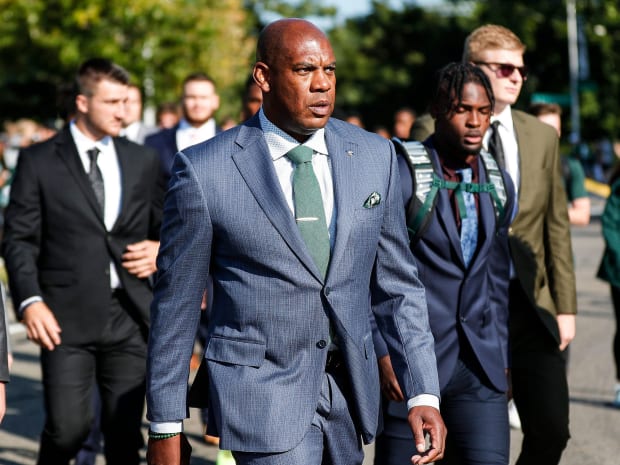
Junfu Han/USA TODAY Network
Berry, himself a former coach at Army and Louisiana-Monroe, says coaches don’t enjoy the hiring and firing cycles and dread “Black Sunday” or “Bloody Sunday,” the nicknames within the industry for the day after the regular season ends. This year, there were multiple Black Sundays, with coaches, coordinators and position coaches fired on a near-weekly basis starting in mid-September.
While athletic director searches can drag on for months, coaching searches now happen quickly. Florida fired Dan Mullen and had his replacement, Louisiana’s Billy Napier, in place within a week, effectively shutting down its broad search after meeting with Napier three days after the job opened. Florida did not lean heavily on a search firm. While search firm officials stress their thoroughness, the time crunch creates a shallow pool of candidates, and decision-makers don’t dedicate much time to the vetting process. This can particularly diminish opportunities for minority coaching candidates, many of whom are searching for a fair shot at jobs.
Further complicating the issue is the high-profile nature of the jobs. In the 2021 cycle, coaching opportunities at USC, Florida, Notre Dame, LSU and Oklahoma have opened. Notre Dame hasn’t had an opening since 2009, while Oklahoma hasn’t had a true job search since 1998.
There are few candidates who programs would consider qualified to take on jobs of that magnitude, creating a supply-and-demand issue when several high-powered programs are competing for a small group of coaches. That drove a hole through the sports money ceiling, which already had elevated dramatically in the past 20 years in concert with skyrocketing TV revenues.
“Now $7 million [for James Franklin at Penn State] looks like a bargain. It wasn’t a week ago,” former athletic director Debbie Yow says. “There’s only a handful of schools that can make this work and make the payments. Even among the Power 5, there are only a few that can do it. The consolidation of power is going to be more prominent. I’m not saying it’s going to be the end of college athletics—I’m not going to be that drastic—but it does change things.”
Twenty years ago, while AD at Maryland, Yow doled out one of the first 10-year contracts to football coach Ralph Friedgen, spreading out $12 million over a decade.
“We didn’t have the money [for a large annual salary], so we gave him the term. Now you’re seeing both, the money and the term,” Yow says.
Michigan State’s Mel Tucker recently received a 10-year, $95 million contract extension while his name was being linked to the LSU job, just as Franklin profited from speculation about interest from LSU and USC. Tucker’s contract numbers were a stunning example of a defensive play against richer programs.

While the length and wealth of the Tucker deal was eye-opening for a coach with a 17–14 career record, what stood out was the buyout terms. The contract is tilted massively in favor of Tucker and against Michigan State: The contract is fully guaranteed should he be fired without cause. But it would cost Tucker only $2.5 million to walk away, and that number will decrease by $500,000 each of the next three years. At Penn State, Franklin’s new contract is similar. The buyout is $6 million by 2023, a manageable number for an opposing school that may want him in the future. It also offers leverage for Franklin to either cash in big somewhere else or again renegotiate terms.
Agents and coaches defend the lopsided buyouts as necessary protection in a volatile industry, where job security is fleeting. Athletic directors point out that buyouts often are paid by individual boosters who are willing to write big checks, as opposed to having it come out of university funds. But that facet of salary escalation has come under the heaviest fire from college athletics watchdog groups and Congress. “That’s probably the most indefensible part of it,” says Tom McMillen, a former college athlete and ex-Congressman who now is the CEO of Lead1, a college athletics lobbying firm. “It’s hard to say you need tax breaks when you’re handing out those buyouts.”
Thus the sport is awash in dead money owed to fired coaches. A recent analysis by ESPN found that $402.3 million in dead money was spent to fire football coaches between January 2010 and January ’21. Auburn led the way, firing two coaches who had been to two national championship games, with one (Gene Chizik) bringing a title back to the Plains. The other (Gus Malzahn) received a record $21.45 million buyout from the school last December.
Some blame agents for running roughshod over desperate athletic directors. Two in particular have consolidated power in the college coaching space: Jimmy Sexton of Creative Artists Agency and Trace Armstrong of Athletes First. Sexton recently grabbed Franklin from Armstrong to go along with a vast stable of SEC coaches. Armstrong, meanwhile, flexed considerable muscle as the representative of Riley and Kelly, shopping both to the same schools and letting it be known they were movable.
One agent tells SI, “My only regret is I don’t have the level of coach to take advantage of these openings.” A current Power 5 AD decried the state of affairs in the hiring-and-firing market but was reluctant to criticize his colleagues. “I might be in that position in a few years, so I don’t want to look like a hypocrite, but it’s alarming.”
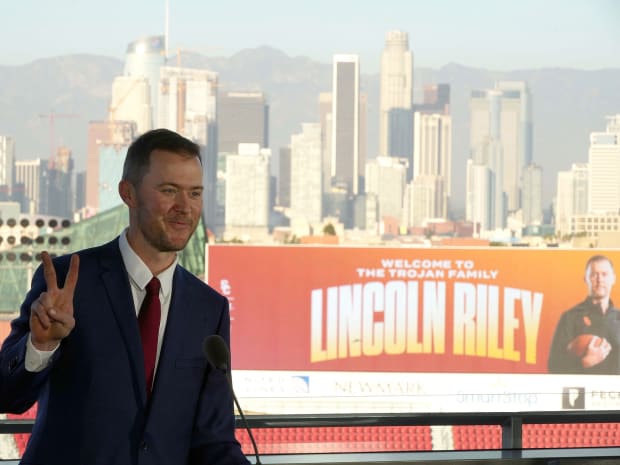
Kirby Lee/USA TODAY Sports
A different Power 5 AD says one way schools can try to tip the scales back in their favor is to hire outside counsel and fight back with information. Where an AD cannot reach out to their peers to do due diligence on how certain deals were structured, or who is or isn’t available without going through a school or an agent, outside counsel can act on their behalf. It also adds a layer of plausible deniability when dealing with candidates during searches. Per sources, Washington’s AD, Jen Choen, used outside counsel while negotiating a deal for new coach Kalen DeBoer.
Outside counsel provides a different set of eyes and a different mouthpiece to negotiate through, one that agents might even be more amenable to deal with in good faith because they speak the same language of legalese that is not bogged down in school-centric politics.
While agents think about job moves 365 days a year, ADs are sometimes blindsided and caught flat-footed because they have to deal with everything within their departments beyond football, although football composes the lionshare of their revenues. Who would have thought, for instance, Florida would be looking for a new coach before the end of the season coming off an SEC East title? But it happened.
“I don’t think the carousel will ever slow down, because there’s winners and losers in this industry,” Turner says. “Everyone wants to be a winner. Everybody can’t be a winner, and naturally they’re gonna keep turning it over until they find one. And if that doesn’t work they’ll continue to do it.”
There is at least one high-level person in college sports who doesn’t seem to think this is a big deal: Sankey. SEC coaches represented five of the top 10 coaching salaries in 2021. That number will likely grow when Oklahoma and Texas join the league. LSU gave Kelly a massive deal fewer than 15 months after the school’s Board of Supervisors lagged to award 3% faculty merit raises.
“Boards and presidents are making decisions about the right people for their program. That’s it. No more or no less from my perspective,” Sankey says. “Those schools are going to make decisions based on their resources.”
For better or worse, there is no multibillion-dollar sporting entity in this country structured like college sports—nonprofit entities that are engaged in a zero-sum competition against other universities.
In 2019 former Stanford golfer Kevin Blue authored a white paper entitled “Rising Expenses in College Athletics and the Non-Profit Paradox.”
Blue, who has a master’s and PhD in Sports Psychology, was an associate AD at Stanford and UC Davis’s athletic director by age 33. In his paper, written while at UC Davis, he lays out how it is by the sport’s very design we were always going to get here:
Unlike professional teams, college athletics departments do not have owners with a personal financial stake in the game. Professional owners want to win, but they are simultaneously incentivized to control costs in order to turn a profit or manage operating losses, and to consider long-term franchise value. These incentives are reflected in league-wide policies developed to control spending and enhance competitive equity, and also in the financial decision-making of team executives.
On the other hand, financial decision-making in college athletics reflects the different set of incentives that the non-profit structure encourages. Every dollar of generated revenue is spent in pursuit of the competitive and student-athlete education missions. Some income might be saved for contingent or long-term use, but none is taken as profits. When revenue increases dramatically, increases in spending quickly follow.
Blue does not blame the administrators who are handing out the massive paychecks and signing the bad contracts.
“For presidents and athletic directors, popularity is the most important form of job security,” Blue tells SI. “The fans want you to spend the money, so you do it to remain popular with the fans. It’s a really difficult political situation. They can’t make the decisions they need to make because they’re trying to maintain their positions.”
It can be said the primary job of a politician is to be reelected, and by extension athletic directors have become more politician-like as the years go on: They want to keep their jobs. Turner has seen this firsthand, as an administrator in his pre-search-firm career and from his own father, who was an athletic director at multiple schools when he was growing up.
“I talked to an AD who recently retired over the summer. They were saying, it’s a different business than it was when I got in it. You don’t get to spend as much time with the student-athletes,” Turner says. “You’re not getting to go to practice. You aren’t getting to know your coaches as well. You’re dealing in board meetings and legislation and NIL, and it’s just a different business than it was 20 years ago. It’s a crazy business.“
While the current scale is unprecedented, the corporatization of college sports is, of course, nothing new. In 1991, then U.S. representative McMillen introduced legislation for an antitrust exemption for the NCAA that would, in part, allow it to limit compensation. It was aimed at a number of things, but salary control was one of them. Nothing came of it, and college athletics was allowed to continually run unabated to where it is now. In a way, Blue—who now works for Golf Canada, the national governing body of that sport —picked up where McMillen left off. And Blue’s work is highly thought of, with multiple people who spoke to SI referencing it.
As Swarbrick noted in the press conference following Kelly’s exit: “We'd better be asking what we want college football to be and how we make sure it still fits inside a university environment.”
The new norm we’ve arrived at may seem absurd, but Blue argues it was always going to get this way as college athletics ran unchecked.
“The behavior is rational,” Blue says. “What is irrational are the people who can have influence and who are not standing up and doing something—the people with reputational currency. The people attached to the big brands have to stand up and be accountable. I was a guy in my mid-30s writing papers while working at a mid-major. I tried.”
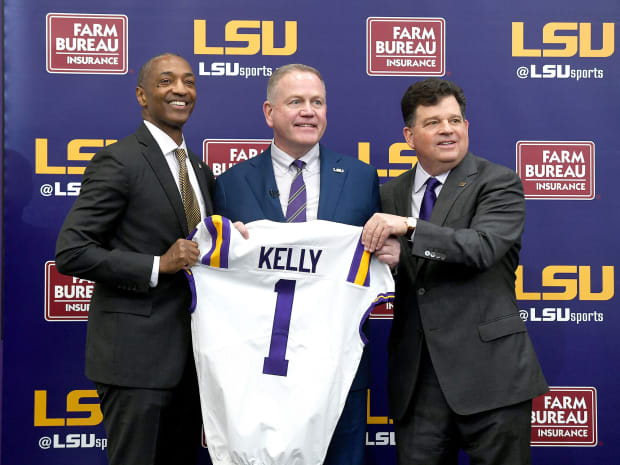
Patrick Dennis/USA TODAY Sports
The fixes are not simple or quick, and the finger-pointing goes in all directions.
The answers ideally could come from within, but given the NCAA’s inability to self-govern and the conferences’ self-interest, those are daunting places to start. And given what Blue and others posit and what fans across the country understand about athletics, regulation could include college sports leaders’ doing something that is the antithesis to the real goal: winning.
“You control it through the president’s office and the board of trustees,” Yow says. “You need people who can say, ‘We may not win the conference championship, but we’re going to have common sense.’ This is tough.”
Telling fans or players or boosters you’re not doing everything you can to win by shelling out money for seemingly great coaches is a near-impossible pill for everyone to swallow.
“There’s a winner and there’s a loser, and everybody wants to win but they’re keeping score,” Turner says. “So there’s consistently going to be losers and there’s going to consistently be fan bases who are passionate about trying to catch the next team that forces the administration’s hand to make changes to try and chase that winning program. It just continues.”
And if change won’t happen from within, it leads to the inevitable trip to Washington, D.C., to stage an another intervention. Thirty years after McMillen’s effort, we could be back there again. “It’s like we’re taunting Congress,” a commissioner recalls. “Federal intervention is inevitable, because we can’t do it ourselves.”
Congress has taken notice, namely by Connecticut Senators Richard Blumenthal and Chris Murphy, both Democrats.
“Something is wrong with this picture,” Blumenthal says. “We’ve just been through a pandemic. A lot of people are really hurting. The point I’d make is, these athletes’ families are really hurting, not to mention the athletes themselves. There is a basic issue of fairness and justice here.”
In a recent public statement, Murphy said, in part:
“Professional-level payouts for college coaches are only possible because colleges and the NCAA illegally collude to directly restrict compensation for the mostly Black athletes so that the mostly white coaches and industry executives get to keep all the profits for themselves. That's shameful. While athletes can finally make money off endorsements, it's clear we need to go further to right the wrongs at the core of the college sports industry.”
Murphy graduated with a law degree from UConn, which got rid of coach Randy Edsall early in the season and replaced him with former NFL and college head coach Jim Mora Jr. Mora’s salary checks in at a modest $1.5 million and, in theory, the timing gives him plenty of time to probe the portal and secure recruits.
The buyout and salary issues, and the spinning coaching carousel, did not become problems overnight. Along with name, image and likeness, you can throw them on the pile of issues that will come up at the next NCAA constitutional convention, in January. Many parties are at fault, but college sports are at a breaking point, wrapped up in an inflection point on top of a tipping point. Reform is in the air and on the docket—the convention promises to be a landmark one, with massive reforms on the table—but it will happen against a backdrop of wild spending and conference realignment.
“All the oxygen has been taken out of the room by the NCAA trying to figure out what and who they are in terms of their governance structure,” Berry says. “How are you gonna move forward to try to eliminate or alleviate some of the problems that we all see are out there, but we don’t know who’s gonna make those decisions moving forward? It becomes difficult for our coaches and for our organization, who has made lots of recommendations for the student-athlete to create not equity, but some fairness in the game.”
As McMillen puts it: “It’s like trying to draft a Constitution in a Category 5 hurricane.”
More College Football Coverage:
• Luke Fickell Staying Would Make Cincy Big Winner
• Blockbuster Moves Headline Wildest Week in CFB History
• Why Playoff Expansion Was Stalled Again
• Notre Dame: The CFP's Unlikely Sympathetic Figure